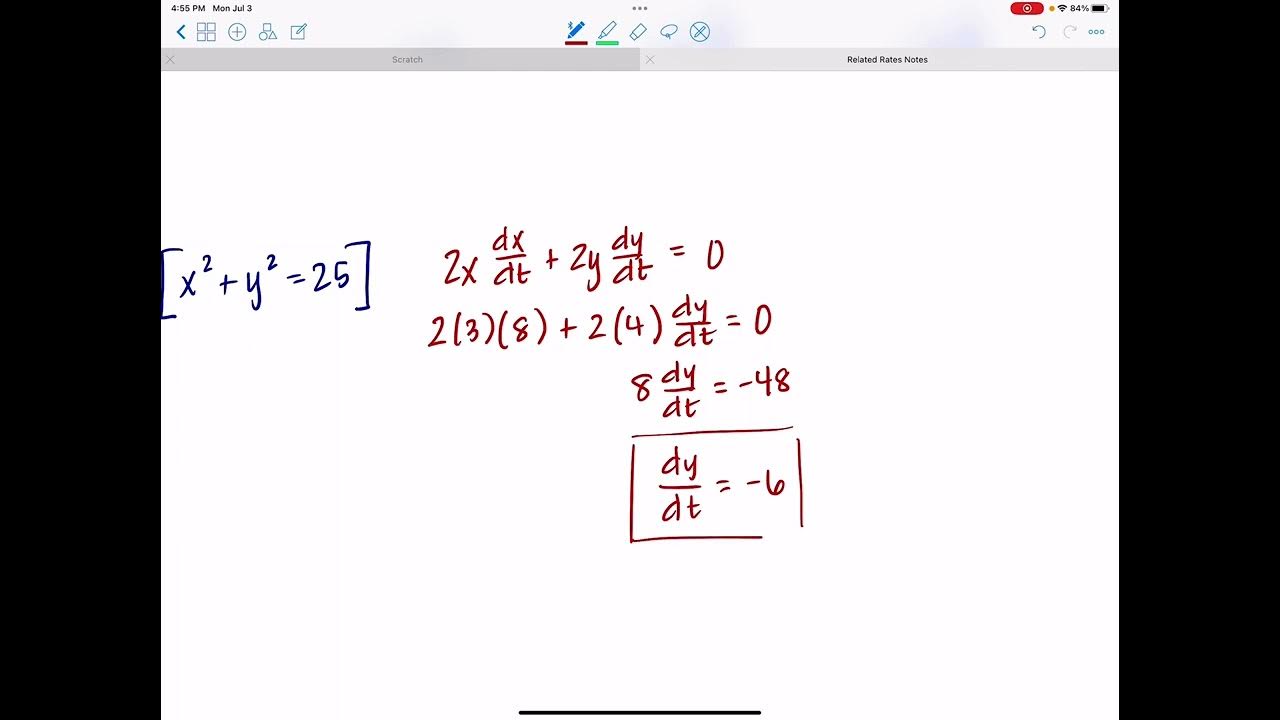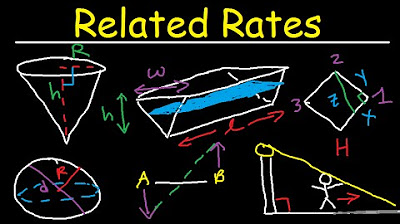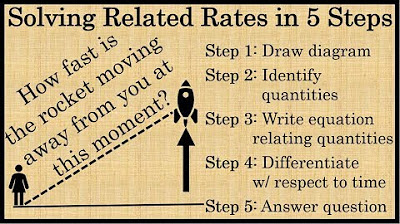Calculus 1 Lecture 2.8: Related Rates
TLDRThe transcript discusses the concept of related rates, focusing on how to relate a formula to its change over time. It uses examples such as a cone filling with water and an oil spill to illustrate how to find the rate of change of volume or area with respect to time. The explanation involves assigning variables, identifying relevant formulas, and using implicit differentiation to calculate the rates of change. The transcript also touches on a rocket launch scenario, where the goal is to determine how fast the angle of elevation must change to keep the rocket in frame at a specific height.
Takeaways
- 📚 The concept of related rates involves finding the rate of change of a formula with respect to time, focusing on how various quantities change as time progresses.
- 🌊 In the context of the provided script, related rates are applied to scenarios such as the filling and emptying of a cone, oil spills, and rocket launches.
- 📈 To solve related rate problems, one must identify the variables involved, assign them letters, and establish a formula that relates these variables.
- 🔄 The process often requires the use of implicit differentiation with respect to time to find the rates of change of the variables involved.
- 🎓 When dealing with rates of change, it's crucial to understand that the rate can vary at different times, so the problem may specify a particular moment in time for the calculation.
- 🚀 In the rocket launch example, the goal is to find out how fast the angle of elevation of a camera must change to keep the rocket in focus as it ascends.
- 📊 The script emphasizes the importance of incorporating all given information into the calculation, such as the rate of change of height and the specific height at a given time.
- 🌐 The script also touches on the application of trigonometry in related rate problems, particularly when dealing with angles and heights, as seen in the rocket launch scenario.
- 🧩 To solve for a specific rate of change, one must take the derivative of the formula relating the variables, substitute the given values, and simplify the expression to find the rate.
- 📝 The script provides a step-by-step approach to solving related rate problems, starting from assigning variables, identifying the formula, taking derivatives, and finally plugging in values to find the answer.
- 🔢 It's important to note that the units of measurement must be considered in the calculations, such as converting radians to degrees when dealing with angular rates of change.
Q & A
What is the main concept of related rates discussed in the transcript?
-The main concept of related rates discussed in the transcript is the process of finding the rate of change of a quantity with respect to time, by relating a formula or a set of variables to time using implicit differentiation.
How does the volume of a cone change with respect to time when it is filling up with water?
-The volume of a cone changes with respect to time by following the formula derived from the implicit differentiation of the volume formula with respect to time, considering the changing height and radius of the cone as functions of time.
What are the necessary components to solve a related rates problem?
-To solve a related rates problem, one must identify the relevant variables, assign them letters, find a formula that relates these variables, take the derivative of this formula with respect to time, and then plug in the given values to find the rate of change at a specific moment in time.
How does the rate of change of the volume of water in a cone relate to the rate of change of its height and radius?
-The rate of change of the volume of water in a cone is related to the rate of change of its height and radius through the implicit derivative of the volume formula with respect to time, which results in an equation involving the rates of change of all variables involved (dV/dt, dH/dt, and dr/dt).
What is the formula used to find the rate of change of the area of an oil spill with respect to time?
-The formula used to find the rate of change of the area of an oil spill with respect to time is the derivative of the area formula with respect to time, which is dA/dt = 2πr(dr/dt), where r is the radius and dr/dt is the rate of change of the radius.
How does the concept of implicit differentiation apply to related rates problems?
-Implicit differentiation is used in related rates problems to find the derivative of a formula that relates multiple variables to time. This allows us to determine the rate of change of one variable with respect to time, considering the other variables as functions of time as well.
What is the significance of the chain rule in solving related rates problems?
-The chain rule is significant in solving related rates problems because it allows us to take the derivative of a function that depends on another function, which is the case when dealing with variables that are all functions of time in a related rates problem.
How does the product rule come into play when differentiating the volume of a cone with respect to time?
-The product rule is applied when differentiating the volume of a cone with respect to time because the volume formula involves the product of the base area (πr^2) and the height (H). When differentiating with respect to time, the product rule is used to find the derivative of this product.
What is the role of the Pythagorean theorem in the context of the rocket launch related rates problem?
-The Pythagorean theorem is not directly used in the context of the rocket launch related rates problem as it does not involve right triangles. Instead, the tangent function and the relationship between the height, the distance from the rocket, and the angle of elevation are used to set up the problem.
How does the secant function come into play in the calculation of the rate of change of the angle of elevation for a rocket launch?
-The secant function comes into play as it is used to express the relationship between the height of the rocket and the distance from the rocket (opposite and adjacent sides of the triangle formed). The derivative of the secant function with respect to time is then used to find the rate of change of the angle of elevation.
What is the final rate of change of the angle of elevation for the rocket launch at 4,000 feet?
-The final rate of change of the angle of elevation for the rocket launch at 4,000 feet is 4.13 degrees per second, which is derived from the calculated derivative and converted from radians to degrees.
Outlines
📚 Introduction to Related Rates
This paragraph introduces the concept of related rates, which involves understanding how various quantities change with respect to time. It discusses the application of formulas to real-world problems such as the changing cost, profit, or volume over time. The example provided is about a cone filling with water, highlighting the need to understand the rate of change of volume at a specific time, such as exactly 3 seconds. The paragraph emphasizes the importance of relating formulas with time to solve these types of problems.
📈 Deriving the Volume of a Cone
In this paragraph, the focus is on deriving the volume of a cone using related rates. It explains that to find the rate of change of the volume of water in the cone with respect to time, one must first understand the formula for the volume of a cone. The paragraph introduces the use of implicit differentiation with respect to time, as the volume, radius, and height are all functions of time. It also emphasizes the importance of understanding the interrelationship between these variables and how they change over time to solve related rate problems.
🌊 Implicit Differentiation and Related Rates
This paragraph delves deeper into the process of implicit differentiation as it applies to related rates. It explains that when taking the derivative of the volume formula with respect to time, both the radius and height terms in the formula must be treated as functions of time. The paragraph also discusses the need for understanding the rate of change of the radius and height to determine the rate of change of the volume. It highlights the importance of knowing the specific rates of change at a given time to solve related rate problems accurately.
🚀 Applying Related Rates to a Rocket Launch
The paragraph presents a practical application of related rates by discussing a scenario where a rocket is launched, and the goal is to keep it centered in a camera's view. The paragraph outlines the need to calculate how fast the angle of elevation of the camera must change to keep up with the rocket's ascent. It introduces the use of trigonometric relationships, specifically the tangent function, to relate the height of the rocket to the angle of elevation. The paragraph emphasizes the importance of identifying the correct relationships and taking derivatives with respect to time to solve the problem.
📐 Solving for Rate of Change in Trigonometric Functions
This paragraph focuses on solving for the rate of change of the angle of elevation using implicit differentiation. It explains the process of taking the derivative of the tangent function with respect to time and how to handle the terms involving the height and the angle. The paragraph also discusses the use of Pythagorean triples to find the relationship between the height and the distance, which is essential for determining the secant of the angle. It concludes by showing how to solve for the rate of change of the angle in degrees per second, providing a clear answer to the problem.
Mindmap
Keywords
💡Related Rates
💡Implicit Differentiation
💡Rate of Change
💡Volume
💡Radius
💡Height
💡Derivative
💡Time
💡Oil Spill
💡Rocket Launch
Highlights
Related rates are used to determine how a formula changes over time, such as cost, profit, or volume.
The concept of related rates involves finding the rate of change of a specific variable with respect to time.
An example of a related rates problem involves a cone filling with water and then leaking out, requiring the calculation of the rate of change of the water's volume.
Implicit differentiation is a key technique used in related rates problems, allowing for the calculation of rates of change with respect to time.
The volume of a cone is given by the formula V = (1/3)πr^2h, which can be used to relate the volume, radius, and height in a related rates problem.
When dealing with related rates, it's crucial to identify the correct formula that relates the variables of interest, such as the area of a circle in the context of an oil spill problem.
In the oil spill example, the area of the oil spill is increasing at a certain rate, and the challenge is to find this rate when the radius of the oil spill is 30 feet.
The tangent function is used in related rates problems involving angles, such as calculating the rate at which the angle of elevation of a camera must change to keep a rocket in frame.
The derivative with respect to time (d/dt) is used to find the rate of change of variables in related rates problems, providing insights into how quantities change over time.
In the rocket example, the height of the rocket is given as a function of time, and the goal is to find the rate of change of the angle of elevation to keep the rocket centered in the camera's view.
Related rates problems require assigning variables to the different quantities involved, such as time (t), height (h), and angle (θ), to set up the appropriate formulas and calculations.
The concept of related rates is not only useful in theoretical mathematics but also has practical applications, such as in the monitoring and control of real-world systems like oil spills or rocket launches.
When solving related rates problems, it's important to identify the given information, such as the rate of change of one variable, and the specific point in time or conditions under which the problem is set.
Related rates problems often involve multiple steps, including identifying the correct formula, taking derivatives, and solving for the rate of change at a specific time or condition.
The process of solving related rates problems can involve converting between different units of measurement, such as radians to degrees, to provide more intuitive results.
The related rates concept is an extension of the implicit differentiation technique, focusing on the rates of change of various quantities with respect to time.
In the context of the rocket launch, the rate of change of the angle of elevation is critical for ensuring continuous tracking of the rocket's trajectory.
Related rates problems test the ability to synthesize mathematical concepts, such as formulas, derivatives, and units conversion, to solve real-world problems efficiently.
Transcripts
Browse More Related Video

Related Rates

Calculus AB Lesson 4.2: Related Rates

Related Rates - Conical Tank, Ladder Angle & Shadow Problem, Circle & Sphere - Calculus

3.8/3.9 - Implicit Differentiation and Related Rates

How to Solve Related Rates Problems in 5 Steps :: Calculus

Business Calculus - Math 1329 - Section 2.6 - Implicit Differentiation and Related Rates
5.0 / 5 (0 votes)
Thanks for rating: